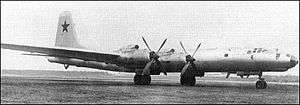Tupolev Tu-85
| Tu-85 | |
|---|---|
 | |
| Role | Heavy bomber |
| National origin | Soviet Union |
| Manufacturer | Tupolev |
| First flight | 9 January 1951 |
| Status | Prototype |
| Number built | 2 |
| Developed from | Tupolev Tu-4 |
The Tupolev Tu-85 (USAF/DoD reporting name 'Type 31',[1] NATO reporting name Barge[2]) was a Soviet prototype strategic bomber based on the Tu-4, an unlicensed reverse engineered copy of the Boeing B-29 Superfortress. It was the ultimate development of the B-29 family, being over 50% heavier than its ancestor and had nearly double the range. Only two prototypes were built before the program was canceled in favor of the Tupolev Tu-95 bomber which was much faster and had the same range.
Development
Neither the Tu-4 nor the Tupolev Tu-80 was a true intercontinental strategic bomber as they both lacked the range to attack the United States from bases in the Soviet Union and return. The Tu-85 was designed to achieve the necessary range by use of more powerful and fuel-efficient engines, a redesigned wing to increase the lift/drag ratio and the addition of more fuel. A large number of engines were considered before settling on the 4,500-horsepower (3,400 kW) Shvetsov ASh-2K, essentially two air-cooled ASh-82 radial engines paired together and the liquid-cooled 4,300-horsepower (3,200 kW) Dobrynin VD-4K six-bank inline engine, similar in configuration to the failed German Junkers Jumo 222. Both engines were given turbochargers and power-recovery turbines which converted them into turbo-compound engines. The Shvetsov design was preferred, but was not yet mature enough for use, and the VD-4K was selected. A lot of effort was put into refining the design of the wing in collaboration with TsAGI. It had an aspect ratio of 11.745 and a taper of 2.93 for optimum lift at high-altitudes.[3] The Tu-85 carried 63,600 litres (16,800 US gal) of fuel in 48 flexible tanks.[4]
Much of the armament and equipment was derived from those of the late-model Tu-4, including the four remotely controlled dorsal and ventral turrets and the tail turret, each with two 23 mm (0.91 in) Nudelman-Rikhter NR-23 cannon. But the Tu-85's tail turret had an Argon ranging radar and each of the two bomb bays was enlarged to hold a 9,000 kg (20,000 lb) FAB-9000 bomb.[3]
Actual design work began in August 1949 and was ratified by a directive from the Council of Ministers dated 16 September that required the first prototype to be ready for manufacturer's tests in December 1950. Construction of the first aircraft began in July 1950 and was completed in September.[5] It first flew on 9 January 1951 and the manufacturer's tests lasted until October 1951. On 12 September the first prototype flew 9,020 km (5,600 mi) with a bomb load of 5,000 kg (11,000 lb) and landed with enough fuel remaining to have covered 12,018 km (7,468 mi).[4] The second prototype, sometimes referred to as the 85D (Russian: dooblyor) or 85/2, incorporated the lessons learned from the first aircraft, including revision and reinforcement of the airframe and a variety of changes to its equipment and systems. It was first flown on 28 June 1951 and its trials lasted until November 1951. Series production was approved on 23 March 1951 at three factories where it would succeed the Tu-4 on the production line, but this was reversed later in the year and the program was cancelled: in the Korean War Soviet MiG-15s brought down many US B-29 bombers, showing that there was no future for piston aircraft in combat use. Priority was given to the higher performance turboprop Tu-95 'Bear',[5] as its own turboprop powerplants, the TV-12 prototype series for the Kuznetsov NK-12 turboprops that power the Tu-95 to this day, was already generating 12,000 shp as early as 1951.[6]
Specifications (Tu-85/1)
Data from Gordon, OKB Tupolev: A History of the Design Bureau and its Aircraft
General characteristics
- Crew: 11–12
- Length: 39.306 m (128.96 ft)
- Wingspan: 55.96 m (183.6 ft)
- Height: 11.358 m (37.26 ft)
- Wing area: 273.6 m² (2,945 ft²)
- Empty weight: 54,711 kg (120,364 lb[4])
- Loaded weight: 76,000 kg (167,200 lb)
- Max. takeoff weight: 107,292 kg (236,534 lb)
- Powerplant: 4 × Dobrynin VD-4K turbo-compound radial engines, 3,200 kW (4,300 hp) each
Performance
- Maximum speed: 638 km/h (344 kn, 396 mph)
- Range: 12,000 km (6,500 nmi, 7,457 mi)
- Service ceiling: 11,700 m (38,376 ft)
- Rate of climb: 17 m/s (3,280 ft/min)
- Wing loading: 277 kg/m² (57 lb/ft²)
- Power/mass: 170 W/kg (0.10 hp/lb)
Armament
- Guns: 10 × 23 mm Nudelman NR-23 cannons, two each in four turrets plus tail barbette
- Bombs: up to 18,000 kg (40,000 lb) of bombs
See also
- Related development
- Aircraft of comparable role, configuration and era
References
Notes
- ↑ "Designations of Soviet and Russian Military Aircraft and Missiles". Designation-systems.net. 18 January 2008. Retrieved 28 September 2011.
- ↑ "Designations of Soviet and Russian Military Aircraft and Missiles". Designation-systems.net. 18 January 2008. Retrieved 28 September 2011.
- 1 2 Gordon, p. 115
- 1 2 3 Gunston, p. 146
- 1 2 Gordon, p. 116
- ↑ Kuznetsov NK-12 (Russian Federation) - Jane's Aero-Engines
Bibliography
External links
| Wikimedia Commons has media related to Tupolev aircraft. |